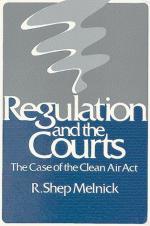|
This section contains 414 words (approx. 2 pages at 300 words per page) |

|
The 1970 Clean Air Act (CAA), significantly amended in 1977 and again in 1990, regulates air pollution emissions from "stationary" sources (e.g., factories, smokestacks, etc.), mobile sources (e.g., motor vehicles), and certain "indirect" sources (e.g., highways, malls, parking lots, etc., that attract mobile sources to the location). Specified "criteria" pollutants such as sulfur dioxide, nitrogen oxide, carbon monoxide, particulates (i.e., soot, fly ash, etc.), and lead are directly regulated, as are "hazardous" air pollutants that the EPA determines are likely to cause death or serious physical injuries. Congress listed some 189 hazardous air pollutants in its 1990 amendments to the original law. Many of these hazardous air pollutants are fairly common chemicals, such as benzene, dry-cleaning solvents, and others that pose scientifically verifiable health dangers. Although it has long been a criteria pollutant, lead is now known to be especially dangerous to human health. The...
|
This section contains 414 words (approx. 2 pages at 300 words per page) |

|


